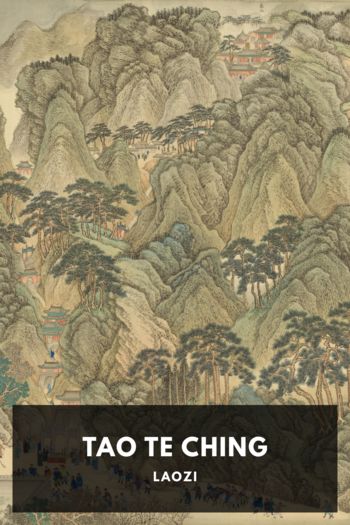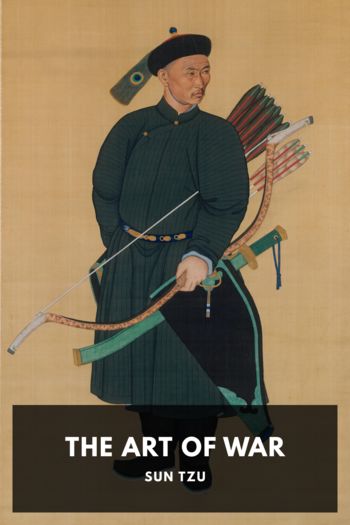Tao Te Ching by Laozi (reading comprehension books txt) 📕

- Author: Laozi
Book online «Tao Te Ching by Laozi (reading comprehension books txt) 📕». Author Laozi
The great Romish mission which continue to the present day began towards the end of the sixteenth century; and there exists now in the India Office a translation of the Tao Te Ching in Latin, which was brought to English by a Mr. Matthew Raper, and presented by him to the Royal Society, of which he was a Fellow, on January 10th, 1788. The manuscript is in excellent preservation, but we do not know by whom the version was made. It was presented, as stated in the “Introduction,” par. 1, to Mr. Raper by P. de Grammont, Missionarius Apostolicus, ex-Jesuita. The chief object of the translator or translators was to show that “the Mysteries of the Most Holy Trinity and of the Incarnate God were anciently known to the Chinese nation.” The version as a whole is of little value. The reader will find, in endnotes 97, its explanation of Lao’s seventy-second chapter;—the first morsel of it that has appeared in print.
Protestant missions to China commenced in 1807; but it was not till 1868 that the Rev. Dr. Chalmers, a member of one of them, published his Speculations on Metaphysics, Polity, and Morality of “The Old Philosopher,” Laozi. Meanwhile, Abel-Rémusat had aroused the curiosity of scholars throughout Europe, in 1823, by his Memoir on the Life and Opinions of Laozi, a Chinese Philosopher of the sixth century before our era, who professed the opinions commonly attributed to Pythagoras, to Plato, and to their disciples. Rémusat was followed by one who had received from him his first lessons in Chinese, and had become a truly great Chinese scholar—the late Stanislas Julien. He published in 1842 “a complete translation for the first time of this memorable work, which is regarded with reason as the most profound, the most abstract, and the most difficult of all Chinese literature.” Dr. Chalmers’s translation was also complete, but his comments, whether original or from Chinese sources, were much fewer than those supplied by Julien. Two years later, two German versions of the treatise were published at Leipzig;—by Reinhold von Plänckner and Victor von Strauss, differing much from each other, but both marked by originality and ability.
I undertook myself, as stated above, in 1879 to translate for The Sacred Books of the East the texts of Taoism which appear in these volumes; and, as I could find time from my labours on The Texts of Confucianism, I had written out more than one version of Lao’s work by the end of 1880. Though not satisfied with the result, I felt justified in exhibiting my general views of it in an article in the British Quarterly Review of July, 1883.
In 1884 Mr. F. H. Balfour published at Shanghai a version of Taoist Texts, Ethical, Political, and Speculative. His Texts were ten in all, the Tao Te Ching being the first and longest of them. His version of this differed in many points from all previous versions; and Mr. H. A. Giles, of H.M.’s Consular Service in China, vehemently assailed it and also Dr. Chalmers’s translation, in the China Review for March and April, 1886. Mr. Giles, indeed, occasionally launched a shaft also at Julien and myself; but his main object in his article was to discredit the genuineness and authenticity of the Tao Te Ching itself. “The work,” he says, “is undoubtedly a forgery. It contains, indeed, much that Laozi did say, but more that he did not.” I replied, so far as was necessary, to Mr. Giles in the same Review for January and February, 1888; and a brief summary of my reply is given in the second chapter of the “Introduction” in this volume. My confidence has never been shaken for a moment in the Tao Te Ching as genuine relic of Laozi, one of the most original minds of the Chinese race.
In preparing the version now published, I have used:—
First, The Complete Works of the Ten Philosophers;—a Suzhou reprint in 1804 of the best editions of the Philosophers, nearly all belonging more or less to the Taoist school, included in it. It is a fine specimen of Chinese printing, clear and accurate. The Treatise of Laozi of course occupies the first place, as edited by Kuei Yu-kuang (better known as Kuei Chên-chʽuan) of the Ming dynasty. The text and commentary are those of Ho-shang Kung (Introd., par. 7), along with the division of the whole into parts and eighty-one chapters, and the titles of the several chapters, all attributed to him. Along the top of the page, there is a large collection of notes from celebrated commentators and writers down to the editor himself.
Second, the Text and Commentary of Wang Pi (called also Fu-ssŭ), who died AD 249, at the early age of twenty-four. See “Introduction,” par. 8.
Third, Helps (lit. Wings) to Laozi; by Chiao Hung (called also Jo-hou), and prefaced by him in 1587. This is what Julien calls “the most extensive and most important contribution to the understanding of Laozi, which we yet possess.” Its contents are selected from the ablest writings on the Treatise from Han Fei (Introd., par.





Comments (0)